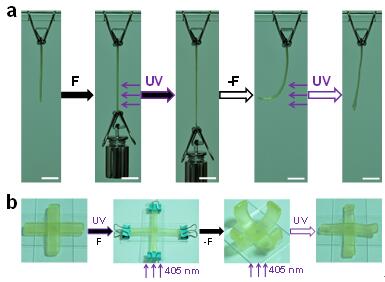Typical cross-linked polymer networks have rubbery elasticity and do not exhibit thermoplasticity like linear polymers. As well known, thermodynamically cross-linked polymer networks exhibit a certain thermoplasticity that allows for thermal processing. Compared with thermal processing, optical processing has distinct advantages. The wavelength, intensity and shape of light could be applied in multiple modes, which is so convenient for precise and remote control that light processing has broad practical applications. The introduction of photo-responsive dynamic covalent cross-linking network in polymer network could not only realize the optical processing of materials, but also construct the photo-responsive smart elastomers. Via sensing light irradiation, smart elastomers will change their molecular structures, and thereby achieve the functions of self-healing, deformation and movement etc., which is not available from traditional polymer materials.
Recently, Pro. Zhu's group from the Wuhan National Laboratory for Optoelectronics, Huazhong University of Science and Technology firstly proposed the concept of “photoplasticity”, which is relative to “thermoplasticity”. Via designing a dynamic and static double cross-linked network (Figure 1a), the photoplastic polyurethane elastomer (PPU) was prepared. The dynamic cross-linked points in PPU is the reversible photo-response hexaarylbiimidazole (HABI) units, while the static cross-linked networks is glycerol units. The photo-reversible dynamic covalent C-N bond in HABI (Figure 1b) endows the PPU elastomers excellent self-healing properties (Figure 1c). Noteworthy, the PPU elastomers obtains photoplasticity different from thermoplasticity. Under the dual actions of irradiation and tension, the PPU elastomers exhibit reversible elongation and contraction, acting like a spring with adjustable elastic modulus by light irradiations (Figure 1d).

Figure 1. The photoplastic mechanism, self-healing and photo-controlled springs of PPU elastomers. (a) The schematic double networks of the PPU materials. (b) The photo-induced cleavage and reformation of the dynamic covalent bonds in HABIs. (c) Self-healing behaviors under visible light irradiation. (d) Photoplastic deformation under the dual actions of visible light irradiation and loading.

Figure 2. Intelligent photo-driven movement. (a) The phototaxis of the PPU elastomers. (b) The photo-driven movement of the biomimetic crucifer.
Furthermore, the PPU elastomer materials exhibit interesting phototaxis. The elastomer show negative and positive phototaxis with or without loading, respectively (Figure 2a). Based on this, they fabricate an actuator with a shape of biomimetic crucifer. The photo-controlled actions of opening and closing of the crucifer are realized with the combined employment of irradiation and tension (Figure 2b).
Photoplastic materials allow for non-contact remote controllable processing of materials and offer a new possibility for the fabrication of functional materials. Meanwhile, as driving devices, the design of photoplastic materials is succinct and exquisite and the functions are powerful and diverse, which provide a new idea for the development of smart materials in the future.
This work is published in Chemistry of Materials (Photoplastic Self-Healing Polyurethane Springs and Actuators, Chem. Mater. 2019, 31, 5081-5088. This work was supported by the National Science Foundation of China, the National Basic Research Program (973) of China and the Fundamental Research Funds for the Central Universities. Shi-Li Xiang are the first author. Prof. Ming-Qiang Zhu and Dr. Chong Li are the corresponding authors.
Full text is available at https://pubs.acs.org/doi/10.1021/acs.chemmater.9b00983